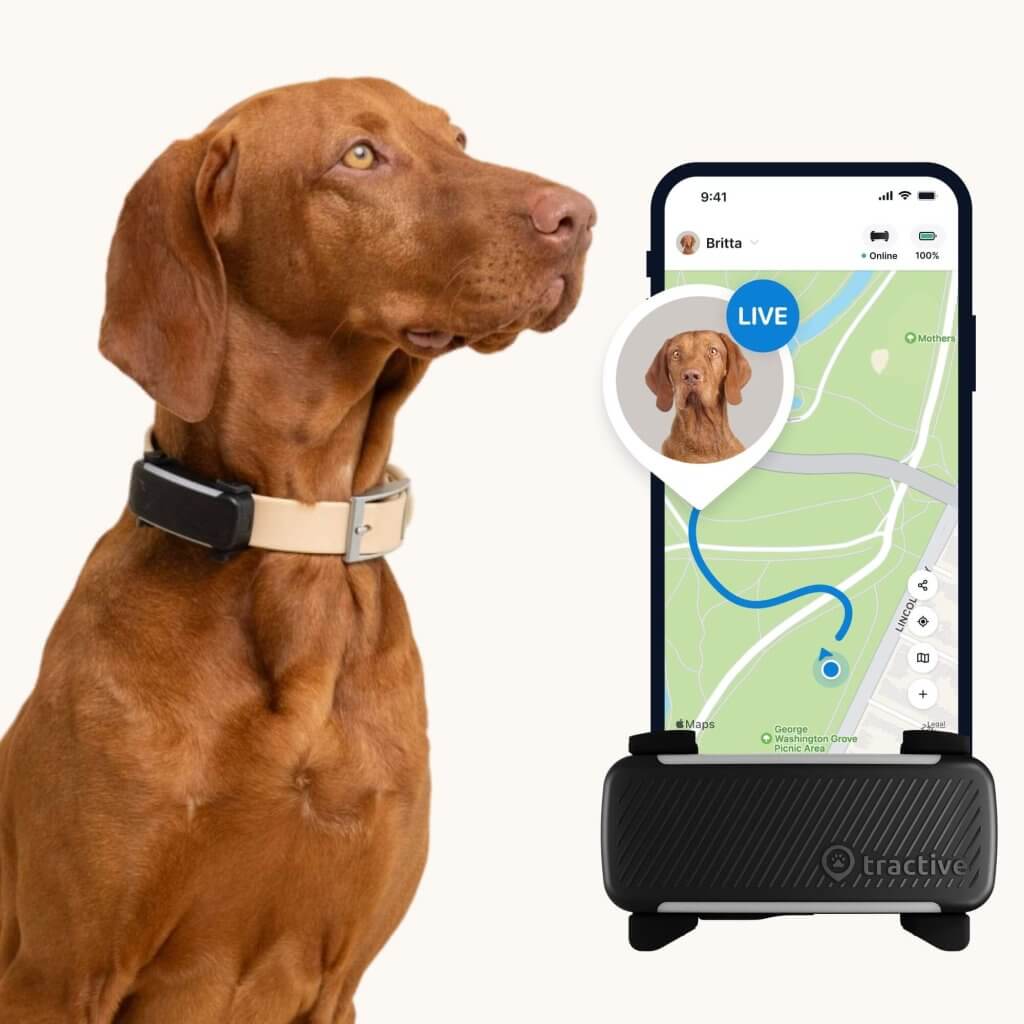Can Dogs Find Their Way Home? And How?
Here's how dogs use their super senses to find their way home even from miles away. (And how you can prevent yours from getting lost.)

Ever wondered if dogs have a built-in GPS in their brains? It can certainly seem that way when you hear incredible stories about dogs traveling miles to reunite with their families. But how do dogs find their way home – and is there a limit to how far they can make their way back?
If you’ve landed here waiting for your missing buddy to come back home, we’ve got you covered. Read on for all the facts and figures on your dog’s “homing” behavior – and how a dog GPS tracker can prevent them from getting lost ever again.

Always know your buddy is healthy & safe
Read moreHow do dogs find their way home?
Your dog’s senses are nothing short of superpowers. It’s usually with a combination of these that they can navigate their way home. Let’s cover each of them, one by one.
- Sense of smell
Dogs’ noses can detect scents over long distances (up to 12 miles, or 20 km!.)1 Including familiar smells – like you, your home, or even the neighborhood park. As your dog walks around familiar territory, their paws leave distinctive scent markers to help guide them home. - Sensitivity to magnetic fields
Some studies believe this helps dogs navigate like a compass, orienting themselves along the earth’s axis.2 - Staying aware of their surroundings
Dogs often remember landmarks, sounds, and even the position of the sun when they’re exploring. All these factors combined create a mental map that helps them find their way back. - Enhanced vision
If you’ve ever wondered, can dogs find their way home in the dark? – the answer is a definite yes. Dogs can navigate surprisingly well at night thanks to their enhanced vision. Their eyes have more rod cells than human eyes, which allow them to see better in low-light conditions.3 - Powerful hearing
Dogs can hear sounds four times further than humans. This includes high frequencies (like dog whistles) which can help them pinpoint exact locations from just one sound. Dogs can also tell the difference between human voices. (Which is where they learn to respond to you calling out their name.) - Knowledge of their territory
When dogs go “missing” within their territory, they’re more likely to return. Using familiar sights, sounds, and smells, they can better understand where they are, orient themselves, and head back home.
⚠️ Around 93% of lost dogs are found alive. But from these, only around 20% of them return home completely on their own.4 They’re usually found because a helpful stranger intervenes and takes them in. So make sure your dog is easy to identify with a collar, ID tag, and microchip. Else, in an emergency, a dog GPS tracker can be a potential lifesaver.

Follow your dog anywhere
Get real-time location information, wherever they go. And find out when they try to make an escape, or just when they go somewhere they shouldn’t, with Virtual Fences.
Can dogs find their way home from long distances?
Your dog can potentially sniff their way home within a 12 mile (20 km) radius. But this applies more so if it’s within familiar territory. Outside of their territory, their “homing” ability can depend on factors like their health, age, and the environment they’re navigating.
For example, how far dogs can smell can depend on factors like:
- The terrain
An open field is easier for a dog to sniff their way back home than a dense forest. Even the time of year can affect your dog’s “homing” sense. In spring, for example, grass tends to grow again – which can potentially throw your dog’s nose off kilter. - The weather
Normally, dogs smell best when they’re in cooler temperatures and it’s not too humid. But if it’s snowing outside, it can mess with their sense of smell. Making it more difficult for them to find their way back home. - Their breed and training
Some dog breeds historically raised to hunt animals can navigate better because of their training. (Think Pointers, Setters, and even Retrievers.) Likewise for “scent hound” breeds, like Beagles and Bloodhounds. - Whether they’re in their territory or not
If your dog gets lost in an unfamiliar area, they might have a harder time finding their way home. Urban environments with busy streets and fewer natural markers can be especially confusing for dogs.
How far away can dogs find their way home?
There isn’t a one-size-fits-all answer, but there’s some anecdotal evidence suggesting that some dogs can find their way home from distances of 20 miles (32 km) or more. For example, Bucky the Labrador travelled around 500 miles (804 km) from Virginia to South Carolina when his owner dropped him over at his dad’s!5
On a more realistic note – while some dogs have traveled hundreds of miles to reunite with their families, it’s not always guaranteed. Your dog’s outdoor skills, survival instincts, and just sheer luck can all play a role.
Can most lost dogs find their own way home?
In most cases, yes. But being lost can often mean your dog gets tired, injured, disoriented in an unfamiliar environment. But here’s the good news. If you’ve taken these steps, you can vastly increase the changes of either someone finding your dog and getting in touch with you – or your dog finding their way home:
- Put out a “lost dog” alert on social media
Include your dog’s photos and details like if they’re microchipped, what they respond to, and your contact details. Make a post on pet search websites like Petcolove and PawBoost to reach out to a wider following. - Ensure your dog is easy to identify
A collar, ID tag, and ideally a microchip can all help make sure a rescuer or helpful stranger doesn’t mistake your dog as a stray. - Leave some food or favorite toys outside
Your dog can pick up on the smell from miles away and it can help them slowly sniff their way back home. - Keep your doors and windows open
This helps the familiar smells of your home reach your dog and help them navigate more easily. - Call out your dog’s name as gently as you can
Else they might hide away from you, especially if they’re already scared. Rather, try and call out their name in the same tone as when you two are together at a park or at home.
Read more: 9 Steps To Find A Lost Dog & Bring Them Home In No Time
How can I prevent my dog from going missing again?
Our dogs are resourceful little troopers – but let’s admit it, no one wants to go through the stress of a lost pet situation. Here are a couple of steps to prevent your buddy from escaping again.
- Keep your dog occupied at home
With toys, puzzle feeders, or interactive toys that make them work to get a treat. Else, some company (like another pet or person) can prevent a boredom-induced runaway attempt. - Keep your dog well-exercised
Switch up your walking routes or try out a new hiking path near you. A tired dog is less likely to run away. - Don’t skip out on your training
Especially commands like “Stay” and coming back to you when called. Check out our guide on dog recall training to ensure your buddy doesn’t disappear out of sight. - Watch out for “runaway triggers”
Dogs run away because of boredom, fear or anxiety from loud noises, the mating instinct, or even prey drive. Keep an eye out for what tends to trigger your buddy’s runaway tendencies the most – and plan ahead. (Like setting up a calm indoor environment if there’s fireworks or a thunderstorm outdoors.)
- Get in touch with your vet
They can best advise you on whether your dog might benefit from anti-anxiety medication or, if you haven’t already, a spaying/neutering procedure. The latter can help reduce roaming behavior and prevent unwanted pregnancies. - Use a GPS tracker in an emergency
With a Tractive GPS strapped to their collar, you can monitor your dog’s real-time location with just a glance at your phone. Or set up a “safe zone” around your home and backyard and get an escape alert the minute your buddy wanders past it.
Meaning once you’ve tried all the above steps and still run into an emergency, your trusty Tractive device has you covered.


So, can dogs find their way home? Absolutely. But with the right tools and precautions, you can make sure they never have to. That way, you’ll both rest easy knowing they’re safe and sound.
Read more: 8 Easy Ways To Find Your Dog With Tractive



